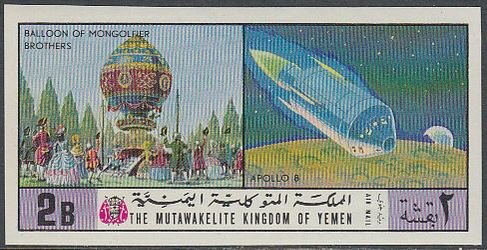Stamp: Balloon of Mongolfier brothers, Apollo 8 (Yemen, Kingdom 1970)
Balloon of Mongolfier brothers, Apollo 8 (Yemen, Kingdom 1970)
15 August (Yemen, Kingdom ) within release Aviation and aerospace goes into circulation Stamp Balloon of Mongolfier brothers, Apollo 8 face value 2 Yemeni buqsha
| Stamp Balloon of Mongolfier brothers, Apollo 8 in catalogues | |
|---|---|
| Michel: | Mi: YE-K 1167B |
Stamp is square format.
Also in the issue Aviation and aerospace:
- Stamp - Balloon of Mongolfier brothers, Apollo 8 face value 2;
- Stamp - Euler biplane 1910, - Apollo 9 face value 4;
- Stamp - H.S. 748, Apollo 10 face value 6;
- Stamp - Douglas C-124 C, Apollo 11 face value 8;
- Stamp - Boeing 707, Apollo 12 face value 20;
- Stamp - Concorde, Apollo 13 face value 1;
- Stamp - Balloon of Mongolfier brothers, Apollo 8 face value 2;
- Stamp - Boeing 707, Apollo 12 face value 20;
- Stamp - Concorde, Apollo 13 face value 1;
- Stamp - Douglas C-124 C, Apollo 11 face value 8;
- Stamp - Euler biplane 1910, - Apollo 9 face value 4;
- Stamp - H.S. 748 - Apollo 10 face value 6;
- Stamp - Man Bird & First Man on the Moon face value 24;
Stamp Balloon of Mongolfier brothers, Apollo 8 it reflects the thematic directions:
A hot air balloon is a lighter-than-air aircraft consisting of a bag, called an envelope, which contains heated air. Suspended beneath is a gondola or wicker basket (in some long-distance or high-altitude balloons, a capsule), which carries passengers and a source of heat, in most cases an open flame caused by burning liquid propane. The heated air inside the envelope makes it buoyant, since it has a lower density than the colder air outside the envelope. As with all aircraft, hot air balloons cannot fly beyond the atmosphere. The envelope does not have to be sealed at the bottom, since the air inside the envelope is at about the same pressure as the surrounding air. In modern sport balloons the envelope is generally made from nylon fabric, and the inlet of the balloon (closest to the burner flame) is made from a fire-resistant material such as Nomex. Modern balloons have been made in many shapes, such as rocket ships and the shapes of various commercial products, though the traditional shape is used for most non-commercial and many commercial applications.
The hot air balloon is the first successful human-carrying flight technology. The first untethered manned hot air balloon flight in the world was performed in Paris, France, by Jean-François Pilâtre de Rozier and François Laurent d'Arlandes on November 21, 1783, in a balloon created by the Montgolfier brothers. The first hot air balloon flown in the Americas was launched from the Walnut Street Jail in Philadelphia on January 9, 1793, by the French aeronaut Jean Pierre Blanchard. Hot air balloons that can be propelled through the air rather than simply drifting with the wind are known as thermal airships.
Outer space (or simply space) is the expanse that exists beyond Earth's atmosphere and between celestial bodies. It contains ultra-low levels of particle densities, constituting a near-perfect vacuum of predominantly hydrogen and helium plasma, permeated by electromagnetic radiation, cosmic rays, neutrinos, magnetic fields and dust. The baseline temperature of outer space, as set by the background radiation from the Big Bang, is 2.7 kelvins (−270 °C; −455 °F)
A spacecraft is a vehicle that is designed to fly and operate in outer space. Spacecraft are used for a variety of purposes, including communications, Earth observation, meteorology, navigation, space colonization, planetary exploration, and transportation of humans and cargo. All spacecraft except single-stage-to-orbit vehicles cannot get into space on their own, and require a launch vehicle (carrier rocket).




